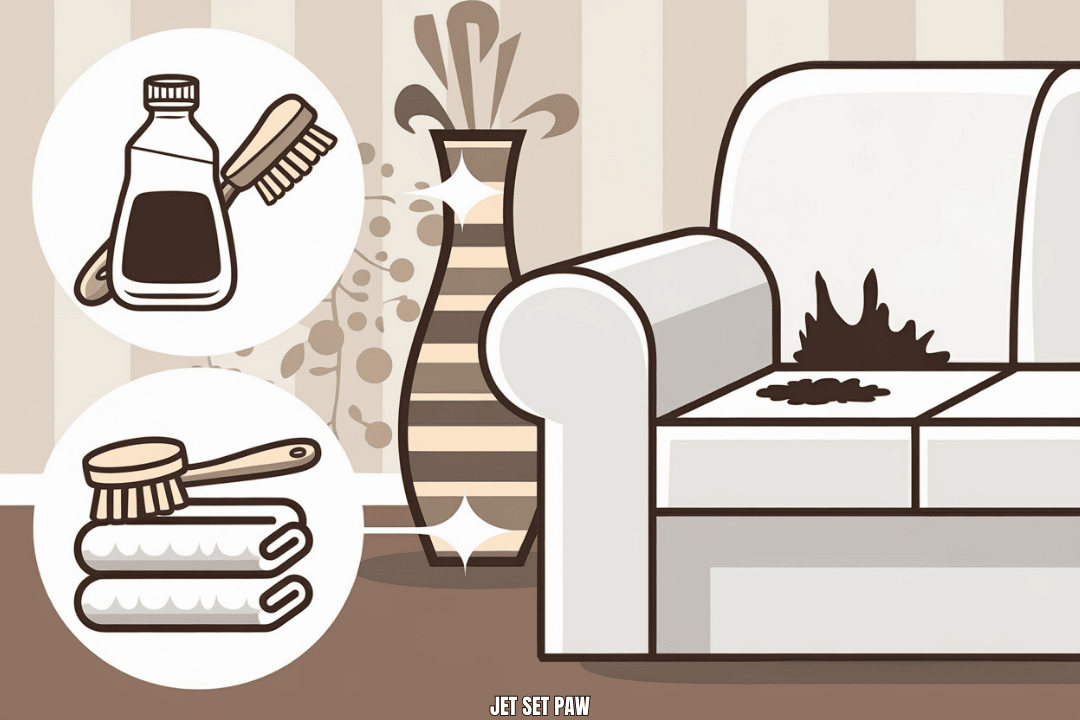Cat pee on the couch is a common and frustrating problem for many pet owners. It’s not just about the unpleasant smell; cat urine can damage your furniture if left untreated.
That’s why cleaning it up as soon as possible is crucial. The longer you wait, the harder it becomes to obliterate the odor and stain. Plus, if your cat smells their urine on the couch, they might think using it as a bathroom is okay.
In this blog post, we’ll explain how to get cat pee out of your couch. We’ll also cover how to find the affected area, clean it properly, and prevent future accidents.
Whether you’re dealing with a fresh or old stain, these tips will help you tackle the problem and save your couch. So, let’s get started on making your living room smell fresh again!
Identify the Affected Area
Finding where your cat peed on the couch is the first step in cleaning it up. You might think it’s easy to spot, but sometimes the stain can be hidden or hard to see. Here are three ways to find the affected area:
First, use your nose to locate the smell. Cat pee has a strong, unmistakable odor. Walk around your couch and sniff carefully. The most potent smell will lead you to the spot where your cat peed.
Try using a blacklight if you can’t find it by smell alone. Turn off the lights in the room and shine the black light on your couch. Cat pee glows under this special light, making seeing even old or faded stains easier.
Lastly, check the couch fabric for wetness or discoloration. Fresh pee will leave a damp spot, while older stains might look darker or different from the rest of the couch. Run your hand gently over the surface to feel for any wet areas.
Cats might pee in more than one spot, so be thorough in your search. Once you’ve found all the affected areas, you can clean them.
Blot the Area
When you find where your cat peed, it’s essential to act fast. The first step is to blot the area to soak up as much urine as possible. Here’s how to do it:
Grab some paper towels or a clean cloth. You want something that can absorb liquid well. If you’re using a fabric, make sure it’s one you don’t mind getting dirty.
Next, press the paper towels or cloth firmly onto the wet spot. Don’t be gentle—you want to apply pressure to soak up as much of the pee as possible.
Keep pressing down for at least a minute. If there’s a lot of urine, you might need to use quite a few paper towels or change your clothes a couple of times.
Here’s an important tip: don’t rub the area. It might seem like rubbing would clean it better, but it does more harm than good.
Rubbing can push the urine deeper into the couch fabric or spread it to a larger area, making the stain bigger and harder to clean. Just press and blot instead.
Keep blotting until your paper towel or cloth is dry. This means you’ve soaked up as much of the urine as you can. Now, you’re ready for the next step in cleaning your couch.
Clean with Enzyme Cleaner
After blotting up as much urine as possible, it’s time to use an enzyme cleaner. Enzyme cleaners are unique products that contain tiny biological helpers called enzymes. These enzymes break down the molecules in cat pee, causing stains and smells.
To use an enzyme cleaner, first read the instructions on the bottle. Usually, you’ll pour it directly on the stain and let it sit for about 15 minutes.
Make sure you use enough cleaner to soak into the fabric where the urine is. After waiting, blot any excess cleaner with a clean, damp cloth.
Enzyme cleaners work best for pet urine because they don’t just cover up the smell – they destroy the smelly stuff. This is important because it helps prevent your cat from wanting to pee in the same spot again.
These cleaners are safe for most fabrics and don’t leave behind harsh chemicals. They keep working even after you’ve cleaned up, making sure all the urine components are broken down.
Remember to be patient when using enzyme cleaners. They might take longer to work than other methods, but they do a much better job in the long run.
Your couch will be clean and fresh-smelling, and your cat will be less likely to have accidents there in the future.
Homemade Cleaning Solutions
If you don’t have an enzyme cleaner, try homemade solutions to clean cat urine from your couch. Two standard options are a vinegar and water mixture and a baking soda paste.
Mix equal parts white vinegar and water in a spray bottle to make a vinegar solution. This mixture helps neutralize the smell of cat urine.
Spray it on the affected area and let it sit for a few minutes. Then, blot the area with a clean cloth to remove the solution and any remaining urine.
Another option is to make a baking soda paste. Mix baking soda with a small amount of water to create a thick paste. Spread this paste over the stained area and let it dry completely.
Once dry, vacuum up the baking soda. This method helps absorb odors and can lift some of the stains.
When using these homemade solutions, always test them on a small, hidden area of your couch first to ensure they won’t damage the fabric. After applying either solution, blot the area well with clean water to remove any leftover cleaner.
While these homemade solutions can be helpful, they may not be as effective as enzyme cleaners for completely removing cat urine odors and stains.
They’re suitable for quick clean-ups, but an enzyme cleaner is usually the best choice for stubborn or repeated accidents.
Deodorize the Area
After cleaning the cat urine from your couch, you might still notice a lingering odor. Deodorizing the area can help get rid of any remaining smells. One simple and effective way to do this is to use baking soda.
Start by sprinkling a generous amount of baking soda over the spot where the cat peed. Make sure to cover the entire affected area. Baking soda is excellent at absorbing odors, so don’t be shy about using plenty of it.
Let it sit overnight once you’ve covered the spot with baking soda. This gives the baking soda time to work its magic. It will absorb any remaining moisture and trap odor-causing particles. The longer you can leave it, the better it will work.
The next day, vacuum up all the baking soda. Use your vacuum cleaner’s brush attachment to get into the fabric and remove all the powder. You should go over the area a few times to get it all.
This baking soda method is safe for most fabrics and can be repeated. It’s a natural way to freshen up your couch without harsh chemicals.
If you still notice a smell after this process, try using an enzyme cleaner again or consider calling a professional cleaner.
Prevent Future Accidents
Cleaning up cat pee is no fun, so it’s essential to try to stop your cat from peeing on the couch again. Here are some ways to prevent future accidents:
Clean the litter box regularly. Cats are clean animals and don’t like using a dirty litter box. Try to scoop out the litter box at least once a day.
Empty and wash the whole box every week or two. You might need more litter boxes if you have more than one cat. A good rule is to have one more litter box than your number of cats.
You can use deterrent sprays on the couch to keep your cat away. These sprays have a smell that cats don’t like but humans can’t smell.
Spray it on the areas where your cat has peed before. Test the spray on a small hidden spot first to ensure it won’t stain your couch.
If your cat keeps peeing on the couch, consider covering it for a while. You can use plastic covers, old sheets, or unique pet covers.
This will protect your couch while you work on solving the problem. It will also make clean-up easier if your cat does have an accident.
Remember, if your cat suddenly starts peeing outside the litter box, it might be a sign of a health problem. Taking your cat to the vet is a good idea to ensure everything is okay.
When to Seek Professional Help
Sometimes, no matter how hard you try, you might not be able to get rid of cat pee stains or smells on your own. You should think about getting professional help.
If you’ve tried cleaning the couch many times and the stain or smell remains, an experienced cleaner can fix it. They have more potent cleaning products and special tools that can work better than what you have at home.
If your couch is very expensive or antique, it’s a good idea to call a professional right away. These types of furniture often need special care, and a professional will know how to clean your couch without damaging it.
Professional cleaning services can do more than clean your couch. They use strong cleaners and machines that can get deep into the sofa to remove stains and smells.
They know how to clean different types of fabric safely. Many also offer treatments to protect your couch from future stains. Some even guarantee their work, meaning they’ll return and try again if you’re not happy with the results.
While it costs more than cleaning it, professional help can be worth it for tough stains or valuable furniture.
Conclusion
Dealing with cat pee on your couch can be frustrating, but it’s a problem you can solve. Let’s quickly go over what we’ve learned. First, clean up the pee as soon as you can. Use paper towels or a cloth to soak up as much as possible.
Then, clean the area with water, vinegar, or a special pet odor cleaner. After cleaning, make sure to dry the area well. You should repeat these steps a few times to eliminate all the smells and stains.
It’s vital to clean up cat pee quickly. The longer it sits, the harder it is to eliminate the smell and stains. Plus, if your cat smells pee on the couch, they might think it’s okay to pee there again. So, act fast when you find an accident.
Remember, many cat owners have dealt with this problem before. You’re not alone, and you can fix this. Be patient and keep trying if the first cleaning doesn’t work.
If you’re still having trouble, don’t be afraid to ask for help from a vet or a professional cleaner. With some effort, you can get your couch clean and fresh again.

